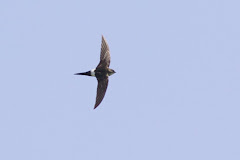With the promise of eagles I headed deep into Sweden today to meet up with
Phil at Båstad. We started at Rönnen at dawn to look for the Gyrfalcon that is marauding the area for its 5th winter in a row. En route we were treated to a Goshawk that flew across the road in front of us and then sat in a tree in the half-light. Although seeing any markings was a challenge at this hour, we could make out a strikingly flared supercilium, rounded tail and 'necky' silhouette which, combined with its flight action, meant we could be confident with the id. Arriving at the Gyr site in a steady drizzle and with visibility like looking through a dirty window with a ten quid pair of binoculars, we struggled to find much of note barring a Peregrine and 3 White-tailed Eagles perched on rocks. Amazingly (for Sweden), we were joined by another birder -
Mikael Olofsson.
After a couple of hours, and as the weather steadily improved, we checked out Farhult where we saw possibly the same, or another, Goshawk that came in from the north being mobbed by Hooded Crows before settling on a post overlooking a large reedbed. After scanning the sea and spying a few Slavonian Grebes, a few Scaup in amongst the Tufted Ducks, a couple of Smew and some Velvet Scoter, we headed inland to look for Golden Eagles with Mikael providing us with some very helpful local knowledge of the tracks and minor roads in the area plus some very good company. A Rough-legged Buzzard was a good start and it wasn't long before we saw our first of 3 more White-tailed Eagles.. then, just as we stopped to check out another possible White-tailed Eagle, an immature Golden Eagle came low from the east and settled in a small copse. Wow! Yet another White-tailed Eagle flew low overhead and a Red Kite drifted lazily past - what a site! By now the weather was sunny and mostly clear but the temperature had dropped and an icy wind was blowing in from the west.
We moved on to Sandön where we saw another Slavonian Grebe and more Smew, then another check of Rönnen produced the same Peregrine Falcon. Leaving Mikael to collect his bike, Phil and I moved up to Torekov, a great site and renowned for Shag (pretty rare in Scandinavia) and Purple Sandpiper. We bagged two of the former and 9 of the latter - not a bad end to a very rewarding day... thanks to Phil for the hospitality and for driving the tank, I mean Volvo, all day and to Mikael for sharing his knowledge and humour.
Photos: immature White-tailed Eagle 























